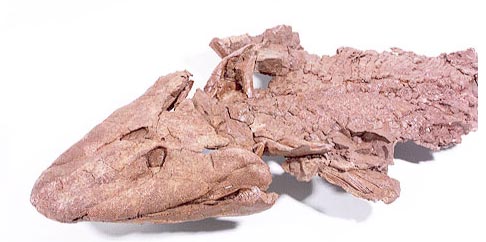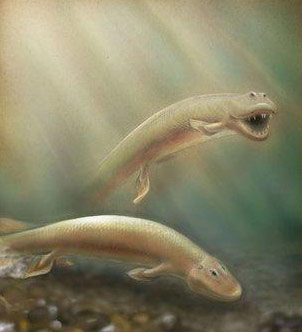Larger and More Developed Pelvic Girdle in Tiktaalik
A team of scientists based in the United States have published research on the pelvic girdle of a transitional sarcopterygian known as Tiktaalik (Tiktaalik roseae). The research team have determined that, much to their surprise, the pelvic girdle of this Late Devonian creature, although primitive, is much more robust than expected. A big, robust pelvis suggests that the hind limbs/fins of this 375 million year old animal were much bigger than previously surmised, this has significant implications for the evolution of tetrapod locomotion.
Tiktaalik
Fossil material, collected from Canada’s Ellesmere Island in 2004 led to the naming and describing of Tiktaalik in 2006. The fossil specimens are highly significant as they represent a transitional form from a fully aquatic fish to a terrestrial animal (tetrapod). At approaching three metres long, Tiktaalik was a sizeable animal. It had a twenty-centimetre-long skull, which consisted of a long snout and relatively short rear portion of the skull.
The shoulder girdle was not joined directly to the back of the skull as seen in contemporaneous fossil material (Panderichthys et al), giving this animal a neck. The front limbs were robust and had a wrist-like structure and the finger-like bones contained within the lobe of a fin. These bones were strong and the wrist-like joint capable of a wide degree of movement suggesting that this half-fish/half amphibian could propel itself along the bottom of a body of water by “walking on its fins”. Analysis of the first fossils also indicated that Tiktaalik had ribs. These ribs could have helped to support the animal as it clambered around on land.
Tiktaalik (Late Devonian) A Transitional Fossil
Picture credit: University of Chicago/Harvard/Academy of Natural Sciences
Tiktaalik Fossils
Intriguingly, although Tiktaalik was named and described nearly eight years ago, the genus was erected based on a study of the front portion of the animal. The first fossils studied consisted of just the front portions, now the research team behind the first scientific descriptions have examined other material excavated from the same location on Ellesmere Island back in 2004 and these fossils have provided them with evidence as to what the rear end of this iconic animal looked like.
In a paper published in the scientific journal “The Proceedings of the National Academy of Sciences”, the research team that included the late Professor Farish Jenkins (Harvard University), one of the last papers that this esteemed professor of vertebrate palaeontology contributed to, outline evidence to suggest that that Tiktaalik had a large pelvis and strong tail fin. This suggests that this animal was able to propel itself around using its four proto-limbs. Such a form of locomotion, often referred to as “four-wheel drive” was thought to have evolved only in later, true tetrapods.
The Scientific Description of Tiktaalik
The authors of this paper, include Dr Neil Shubin (University of Chicago) and Dr Edward Daeschler (Drexel University, Philadelphia), these scientists along with Professor Jenkins, were responsible for the scientific description of Tiktaalik back in 2006. Only now, once other specimens have been fully prepared can the team describe the rear end of this important transitional vertebrate. The fossils show that Tiktaalik had a thick, powerful rear fin, but the real surprise came when the scientists took a look at the pelvic area. The pelvis area, indicated by impressions preserved in the ancient fossilised sediments and several fossilised bones from the hind portions indicate that the rear fins were comparable in size to the front fins. The shape and size of the hip socket also suggest that the rear fins were capable of a wide range of movement.
The rear fins could have been used to help support the animal’s weight as well as help it to swim through water. Although, the overall structure of the pelvis is substantially more developed than that seen in other types of Devonian fish, it is still very primitive when compared to the early tetrapods like Acanthostega and Ichthyostega. The pelvis is still more-fish like, it consists of just one bone, whereas, the pelvis of tetrapods (even ours for example consists of three bones – the ilium, the pubis, and the ischium).
Unfortunately, no evidence of a femur (thigh-bone) has been found but it is very likely that Tiktaalik had a pair of femurs. Tiktaalik is termed a tetrapodomorph – a transitional form between an aquatic creature and one capable of living on land.
Commenting on this latest research, Dr Daeschler stated:
“The pelvis is as large as the shoulder girdle, and that’s not what we would have expected in this finned stage in the fin-to-limb transition. We would have expected the pelvic fins to be smaller.”
Based on this research, the team conclude that the basic, quadrupedal locomotion once thought to have evolved with the first true tetrapods seems to be present in anatomies of fishes like Tiktaalik.
Dr Daeschler added:
“Tiktaalik probably had the ability to use those fins as props to move along, using them to push along the shallow bottom, to work its way through plants and, who know, maybe it got out of the water briefly if it needed to move over to another watercourse. But in no way was it specialised for getting out of the water. It may have had some ability to do that, but everything about its reproduction, its sensory system, its hunting and breathing – all these things tied it to the water.
“Rise of the Animals”
Recently, Sir David Attenborough presented a two-part BBC television programme “Rise of the Animals: Triumph of the Vertebrates”. This programme documented the evolution of animals with backbones from the earliest forms that swam in Cambrian seas to the evolution of mammals, primates and ultimately ourselves. Tiktaalik featured prominently in the first part of the documentary, some wonderful animation showed how vertebrate palaeontologists imagined Tiktaalik used its appendages to get itself about. Interestingly, in the clip the rear limbs are featured, but they do not play any part in the locomotion of the animal. This new research suggests that Tiktaalik used its four proto-limbs in a quadrupedal motion.
Tiktaalik (T. roseae) A Life Reconstruction







Leave A Comment